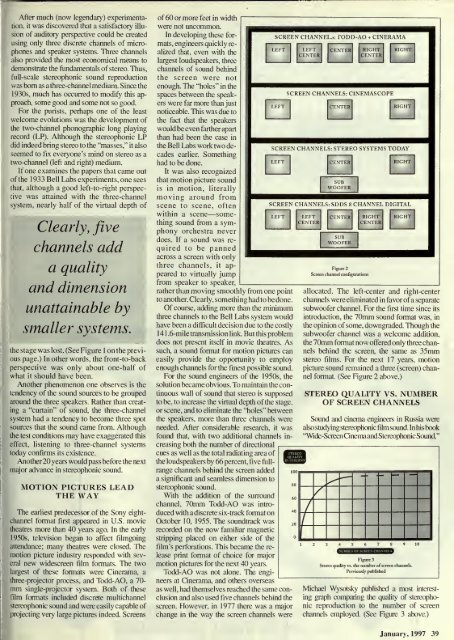You also want an ePaper? Increase the reach of your titles
YUMPU automatically turns print PDFs into web optimized ePapers that Google loves.
After much (now legendary) experimentation,<br />
it was discovered that a satisfactory illusion<br />
of auditory perspective could be created<br />
using only three discrete channels of microphones<br />
and speaker systems. Three channels<br />
al.so provided the most economical means to<br />
demonstrate the fiindamentals of stereo. Thus,<br />
full-scale stereophonic sound reproduction<br />
was bom as a three-channel medium. Since the<br />
1930s, much has occurred to modify this approach,<br />
.some good and some not so good.<br />
For the purists, perhaps one of the least<br />
welcome evolutions was the development of<br />
the two-channel phonographic long playing<br />
record (LP). Although the stereophonic LP<br />
did indeed bring stereo to the "masses," it also<br />
seemed to fix everyone's mind on stereo as a<br />
two-channel (left and right) medium.<br />
If one examines the papers that came out<br />
of the 1933 Bell Labs experiments, one sees<br />
that, although a good left-to-right perspective<br />
was attained with the three-channel<br />
system, nearly half of the virtual depth of<br />
Clearly, five<br />
channels add<br />
a quality<br />
and dimension<br />
unattainable by<br />
smaller systems.<br />
the stage was lost. (See Figure 1 on the previous<br />
page.) In other words, the front-to-back<br />
perspective was only about one-half of<br />
what it should have been.<br />
Another phenomenon one observes is the<br />
tendency of the sound sources to be grouped<br />
around the three speakers. Rather than creating<br />
a "curtain" of sound, the three-channel<br />
system had a tendency to become three spot<br />
sources that the sound came from. Although<br />
the test conditions may have exaggerated this<br />
effect, listening to three-channel systems<br />
today confirms its existence.<br />
Another 20 years would pass before the next<br />
major advance in stereophonic sound.<br />
MOTION PICTURES LEAD<br />
THE WAY<br />
The earUest predecessOT of the Sony eightchannel<br />
format first appeared in U.S. movie<br />
theatres more than 40 years ago. In the early<br />
1950s, television began to affect filmgoing<br />
attendance; many theatres were closed. The<br />
motion picture industry responded with several<br />
new widescreen fihn formats. The two<br />
largest of these formats were Cinerama, a<br />
three-projector process, and Todd-AO, a 70-<br />
mm single-projector system. Both of these<br />
film formats included di-screte multichannel<br />
stereophonic sound and were easily capable of<br />
projecting very large pictures indeed. Screens<br />
of 60 or more feet in width<br />
were not uncommon.<br />
In developing these formats,<br />
engineers quickly realized<br />
that, even with the<br />
largest loudspeakers, three<br />
channels of sound behind<br />
the screen were not<br />
enough. The "holes" in the<br />
spaces between the speakers<br />
were far more than just<br />
noticeable. This was due to<br />
the fact that the speakers<br />
would be even farther apart<br />
than had been the case in<br />
the Bell Labs work two decades<br />
earlier. Something<br />
had to be done.<br />
It was also recognized<br />
that motion picture sound<br />
is in motion, literally<br />
moving around from<br />
scene to scene, often<br />
within a scene—something<br />
sound lirom a symphony<br />
orchestra never<br />
does. If a sound was required<br />
to be panned<br />
across a screen with only<br />
three channels, it appeared<br />
to virtually jump<br />
from speaker to speaker,<br />
rather than moving smoothly from one point<br />
to another. Clearly, something hadto be done.<br />
Of course, adding more than the minimum<br />
three channels to the Bell Labs system would<br />
have been a difficult decision due to the costly<br />
1 4 1 .6-mile transmission hnk. But this problem<br />
does not present itself in movie theatres. As<br />
such, a sound format for motion pictures can<br />
easily provide the opportunity to employ<br />
enough channels for the finest possible sound.<br />
For the sound engineers of the 1950s, the<br />
solution became obvious. To maintain the continuous<br />
wall of sound that stereo is supposed<br />
to be, to increase the virtual depth of the stage,<br />
or scene, and to eUminate the "holes" between<br />
the speakers, more than three channels were<br />
needed. After considerable research, it was<br />
found that, with two additional channels increasing<br />
both the number of directional<br />
cues as well as the total radiating area of<br />
the loudspeakers by 66 percent, five fullrange<br />
channels behind the screen added<br />
a significant and seamless dimension to<br />
stereophonic sound.<br />
With the addition of the surround<br />
channel, 70mm Todd-AO was introduced<br />
with a discrete six-track format on<br />
October 10, 1955. The soundtrack was<br />
recorded on the now familiar magnetic<br />
stripping placed on either side of the<br />
film's perforations. This became the release<br />
print format of choice for major<br />
motion pictures for the next 40 years.<br />
Todd-AO was not alone. The engineers<br />
at Cinerama, and others overseas<br />
as well, had themselves reached the same conclusion<br />
and also used five channels behind the<br />
screen. However, in 1977 there was a major<br />
change in the way the screen channels were<br />
SCREEN CHANNEL.,: fODD-AO<br />
LEFT<br />
CINERAMA

















